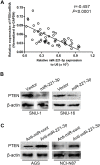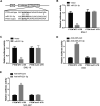MicroRNA-221-3p Plays an Oncogenic Role in Gastric Carcinoma by Inhibiting PTEN Expression
- PMID: 27712596
- PMCID: PMC7841127
- DOI: 10.3727/096504016X14756282819385
MicroRNA-221-3p Plays an Oncogenic Role in Gastric Carcinoma by Inhibiting PTEN Expression
Retraction in
-
Retraction: MicroRNA-221-3p Plays an Oncogenic Role in Gastric Carcinoma by Inhibiting PTEN Expression.Oncol Res. 2025 Aug 28;33(9):2601. doi: 10.32604/or.2025.071885. eCollection 2025. Oncol Res. 2025. PMID: 40918467 Free PMC article.
Abstract
Gastric carcinoma is one of the most common malignancies in men, and microRNA plays a critical role in regulating the signaling networks of gastric carcinoma tumorigenesis and metastasis. We first report the functional characteristics of miR-221-3p in gastric carcinoma. Quantification in gastric carcinoma cell lines and tumor samples reveals significantly increasing miR-221-3p expression. Moreover, a high level of miR-221-3p is correlated with a poor prognosis for gastric carcinoma patients. Ectopic miR-221-3p expression significantly promotes gastric carcinoma cell proliferation, invasion, and sphere formation, while silencing miR-221-3p significantly inhibits these abilities in gastric carcinoma cells. Tests in vivo showed that miR-221-3p significantly promotes tumor growth in xenograft mouse models. In this study, we reveal that miR-221-3p targets PTEN mRNA and downregulates PTEN, which is the possible mechanism of miR-221-3p-induced oncogenic properties. Collectively, we reveal a critical role for miR-221-3p in gastric carcinoma development and progression.
Conflict of interest statement
The authors declare no conflicts of interest.
Figures











Similar articles
-
MicroRNA-34c-3p promotes cell proliferation and invasion in hepatocellular carcinoma by regulation of NCKAP1 expression.J Cancer Res Clin Oncol. 2017 Feb;143(2):263-273. doi: 10.1007/s00432-016-2280-7. Epub 2016 Oct 4. J Cancer Res Clin Oncol. 2017. PMID: 27704267 Free PMC article.
-
Long non-coding RNA MIR22HG impedes the progression of anaplastic thyroid carcinoma via targeting miR-141-3p/PTEN/AKT axis.Endokrynol Pol. 2025;76(4):385-396. doi: 10.5603/ep.104958. Epub 2025 May 7. Endokrynol Pol. 2025. PMID: 40331835
-
IL-21R functions as an oncogenic factor and is regulated by the lncRNA MALAT1/miR-125a-3p axis in gastric cancer.Int J Oncol. 2019 Jan;54(1):7-16. doi: 10.3892/ijo.2018.4612. Epub 2018 Oct 31. Int J Oncol. 2019. PMID: 30387833 Free PMC article.
-
miR-29a-3p compositely regulates the COL6A6/PTEN-PI3K/Akt/CUX1 feedback loop to participate in the proliferation and invasion of pituitary adenomas.J Mol Histol. 2025 May 27;56(3):172. doi: 10.1007/s10735-025-10436-0. J Mol Histol. 2025. PMID: 40419838 Free PMC article.
-
MicroRNAs that regulate PTEN as potential biomarkers in colorectal cancer: a systematic review.J Cancer Res Clin Oncol. 2020 Apr;146(4):809-820. doi: 10.1007/s00432-020-03172-3. Epub 2020 Mar 7. J Cancer Res Clin Oncol. 2020. PMID: 32146564 Free PMC article.
Cited by
-
miR-221-3p Delivered by BMMSC-Derived Microvesicles Promotes the Development of Acute Myelocytic Leukemia.Front Bioeng Biotechnol. 2020 Feb 14;8:81. doi: 10.3389/fbioe.2020.00081. eCollection 2020. Front Bioeng Biotechnol. 2020. PMID: 32117949 Free PMC article.
-
miR-221-3p Drives the Shift of M2-Macrophages to a Pro-Inflammatory Function by Suppressing JAK3/STAT3 Activation.Front Immunol. 2020 Jan 27;10:3087. doi: 10.3389/fimmu.2019.03087. eCollection 2019. Front Immunol. 2020. PMID: 32047494 Free PMC article.
-
microRNAs Promoting Growth of Gastric Cancer Xenografts and Correlation to Clinical Prognosis.Cancer Genomics Proteomics. 2021 Jan-Feb;18(1):1-15. doi: 10.21873/cgp.20237. Epub 2021 Jan 8. Cancer Genomics Proteomics. 2021. PMID: 33419892 Free PMC article. Review.
-
miR‑221‑3p promotes the cell growth of non‑small cell lung cancer by targeting p27.Mol Med Rep. 2019 Jul;20(1):604-612. doi: 10.3892/mmr.2019.10291. Epub 2019 May 23. Mol Med Rep. 2019. PMID: 31180541 Free PMC article.
-
miR-221-3p promotes hepatocellular carcinogenesis by downregulating O6-methylguanine-DNA methyltransferase.Cancer Biol Ther. 2020 Oct 2;21(10):915-926. doi: 10.1080/15384047.2020.1806642. Epub 2020 Oct 6. Cancer Biol Ther. 2020. PMID: 33023393 Free PMC article.
References
-
- Siegel RL, Miller KD, Jemal A. Cancer statistics, 2015. CA Cancer J Clin. 2015;65:5–29. - PubMed
-
- Zhang H, Qu Y, Duan J, Deng T, Liu R, Zhang L, Bai M, Li J, Zhou L, Ning T, Li H, Ge S, Li H, Ying G, Huang D, Ba Y. Integrated analysis of the miRNA, gene and pathway regulatory network in gastric cancer. Oncol Reps. 2016;35:1135–46. - PubMed
Publication types
MeSH terms
Substances
LinkOut - more resources
Full Text Sources
Other Literature Sources
Medical
Research Materials
